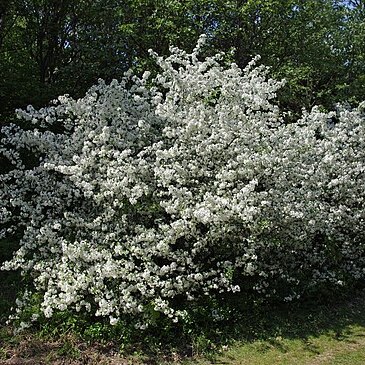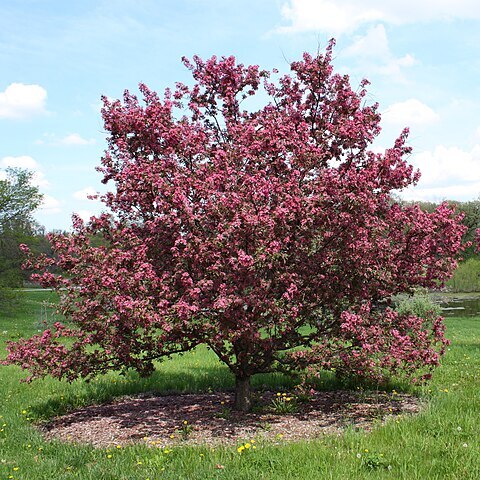Shrubs or trees, 2–200 dm. Stems 1+ (derived from root shoots), erect; bark dark brown, reddish brown, or gray, ?firm, platy or scaly?; long and short shoots present; thorns present (modified short shoots); glabrous, glabrescent, villous, densely puberulent, or tomentose. Leaves deciduous [semipersistent], cauline, simple, ?shoot dimorphism, long-and juvenile-shoot leaves usually larger and more deeply serrate (lobed) than short-shoot leaves?; stipules deciduous (or persistent on vigorous shoot leaves in M. baccata), basally adnate to petiole, linear-lanceolate to lanceolate, sometimes filiform, ?membranous, sometimes herbaceous?, margins entire, serrulate, glandular-serrate, sparsely glandular-denticulate, or white-ciliate; petiole present; blade elliptic, ovate, obovate, triangular-ovate, oval, lanceolate, ovate-oblong, or oblong, (2–)4–12 cm, membranous or leathery, margins flat, sometimes lobed, dentate, serrulate, serrate, doubly serrate, crenate, or sometimes entire, venation pinnate (craspedodromous when lobed, camptodromous when unlobed), surfaces glabrous or tomentose. Inflorescences terminal ?on short shoots?, 2–12-flowered, ?flat-topped? panicles, glabrous or tomentose; bracts present (absent in M. fusca), ?caducous, ovate, linear-lanceolate, membranous, glabrous?; bracteoles present. Pedicels present. Flowers bisexual (occasionally andromonoecious in M. halliana), opening with leaves, perianth and androecium epigynous, 15–50 mm diam.; hypanthium campanulate, size not recorded, glabrous or tomentose; sepals 5, reflexed to wide spreading, triangular, triangular-lanceolate, triangular-ovate, or lanceolate; petals 5 (or more in M. halliana), white, pink, or red, suborbiculate, obovate, narrowly or oblong-obovate, ovate, or ± elliptic, ?base clawed?; stamens 15–50, ?unequal?, usually shorter than, rarely equal to, petals; carpels 3–5, connate, adnate to hypanthium, styles ?3–5?, emerge from base of hypanthium, basally connate, ?glabrous or tomentose basally?; ovules 2. Fruits pomes, green, yellow, or red, globose, depressed-globose, obovoid, or oblong, 6–50(–70) mm diam., ?glaucous, waxy?, punctate; ?flesh homogeneous, stone cells adjacent to carpels and epidermis?; hypanthium persistent; sepals persistent or deciduous, erect or reflexed; carpels cartilaginous; styles persistent or deciduous. Seeds 2 per carpel, ?light, dark, or reddish brown, smooth?. x = 17.
More
Deciduous or rarely semi-evergreen, shrubs or trees, not armed or rarely spiny; stems spreading to erect, sometimes suckering, often tomentose when young. Lvs distributed along long shoots or in fascicles on short shoots, sometimes present on older stems, simple or sometimes lobed, usually crenate or serrate; stipules usually small and free, deciduous, confined to long shoots. Fls in small umbel-like clusters, usually on short shoots, 5-merous, ☿, pedicellate, often showy. Hypanthium tubular, closed at apex. Epicalyx 0. Calyx of sepals connate below; lobes short, usually persistent. Petals 5, suborbicular to ovate, spreading, white, pale pink to deep red. Stamens 15-50. Ovary inferior; carpels 3-5; styles usually 5, connate at base; ovules 2 or more per carpel. Fr. a pome, ovoid, ovoid-oblong, subglobose to globose, often large and very fleshy, usually lacking stone cells; flesh often sweet; skin green, yellow or red, sometimes streaked; carpel walls papery; seeds several.
Trees or shrubs, deciduous or semievergreen, usually unarmed; buds ovoid, with several imbricate scales. Leaves alternate, simple, petiolate, stipulate, venation craspedodromous or camptodromous and merely toothed, margin serrate or lobed, folded or convolute in bud. Inflorescences corymbose-racemose. Flowers pedicellate. Hypanthium bowl-shaped. Sepals 5, persistent or caducous. Petals 5, white, pink, or red, suborbicular or obovate. Stamens 15–50, with white filaments and yellow anthers. Ovary inferior, 3–5-loculed, with 2 ovules in each cell; styles 3–5, connate at base, glabrous or pubescent. Pome usually not containing stone-cells or present in a few species, 3–5-loculed, 1-or 2-seeded in each cell, with cartilaginous endocarp (core). Seeds brown or black, cotyledons plano-convex.
Trees or shrubs, unarmed or with thorns, mostly deciduous. Leaves simple, lobed or toothed. Flowers in few-flowered, simple racemes. Hypanthium with a free rim above the ovary, the rim persistent or rupturing after anthesis. Ovary inferior, carpels completely ad-nate with the hypanthium and without exposed free top, 3-5-celled, styles connate at base. Fruit a pome, mesocarp fleshy, in most species without stone cells, endocarp cartilaginous.


